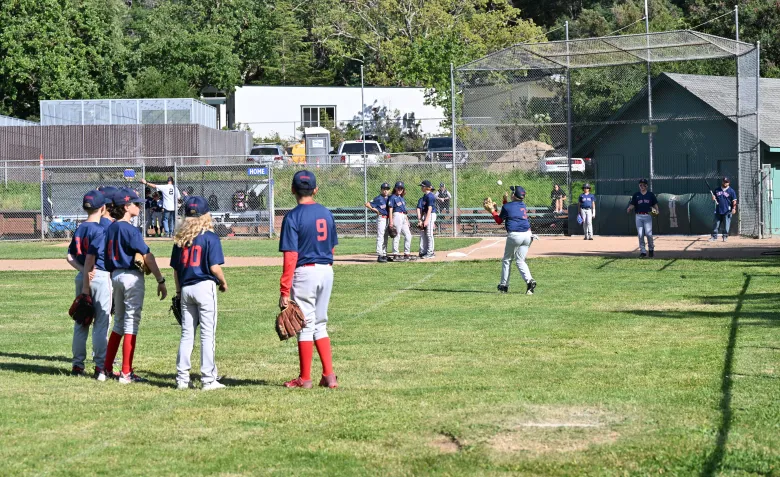
Players from the Red Sox, a Majors Division team for 10-12-year-olds, warm up before their game at the Gallinas Valley Little League field in San Rafael, Calif. on Wednesday, 1, 2024. (Sherry LaVars/Marin Independent Journal)
The San Rafael City School District is diving into hot political waters.
They need only ask their colleagues in the Ross Valley and Mill Valley school districts.
San Rafael is taking a fresh look at its ledger of properties. Some may be viable sites for housing – and for generating income for the district’s budget.
Many Marin districts, having closed campuses due to cycles of declining enrollment, have become long-term landlords, renting out surplus school facilities and generating revenue it could use for capital improvements and repairs for their campuses and other properties.
In recent years, the dilemma has been over what to do with community-based tenants that are renting closed schools.
That’s the quandary facing San Rafael officials.
In Mill Valley, there is a longstanding agreement between the city and the school district that let the city turn school district land into sports fields with the city taking responsibility for the improvements and maintenance.
In Ross Valley, the district stirred controversy with its vote to evict the Fairfax-San Anselmo Children’s Center from Fairfax’s Deer Park School, the popular center’s home for decades. The district based its decision on warnings about safety of the old school and worries about its liability. After months of discord, an agreement was struck to sell the property to a community-based nonprofit organized to not only keep the center, but also promised to make needed repairs.
In Mill Valley, the school board sparked a community dispute when it considered taking back its property to build a new middle school. That scenario promised to save the district money over building the middle school on its current site and installing portables for temporary classrooms during construction.
The proposal generated so much political opposition, including threat of a lawsuit, that the school board dropped it.
In both cases, the decision sided with preserving community-serving uses.
San Rafael is considering its varied properties to determine whether any could be declared surplus and sold.
Leaders of the Gallinas Valley Little League were surprised to find the ballfields they rent and maintain at the old Gallinas School campus in Santa Venetia on that list. Their baseball fields – diamonds that are counted as among the best in Marin – are used by 400 boys and girls, ages 4 to 16.
That real estate plays an important and healthful role in their lives and it cannot be easily replaced.
It comes as no surprise, league leaders are fighting to keep the district from posting “For Sale” signs on the campus.
The district could use the revenue, and sites for needed housing are few, but school officials also need to give priority to community-serving uses and the property’s public ownership.
The district says it is “ultimately seeking the highest and best use, and fair market value” for its surplused properties.
So where does a treasured Little League ballfield fit into that goal? What about the early childhood education services that Community Action Marin has held at the old school?
Neither want to move. That’s understandable.
Both also perform important services to the community – aka “the public.”
Taxpayers originally acquired the property to be used by the community. As the need for the property for a school has diminished amid the enrollment decline, needs of the community have not.
In the case of Gallinas School, its role in meeting the needs of youth recreation and for early childhood education service have not diminished. They should remain a community priority that the school district should strive to protect in its decision-making process.
School officials shouldn’t approach the decisions as private real estate investors. They are holders of community property and should weigh what is best for the community. The “highest and best use” is not always one that generates the highest price.
Nonprofit tenants need to pay their way. The district’s ongoing costs of maintaining and repairing surplus properties have to be covered, but a negotiated break-even lease is a fair and community-serving strategy.
